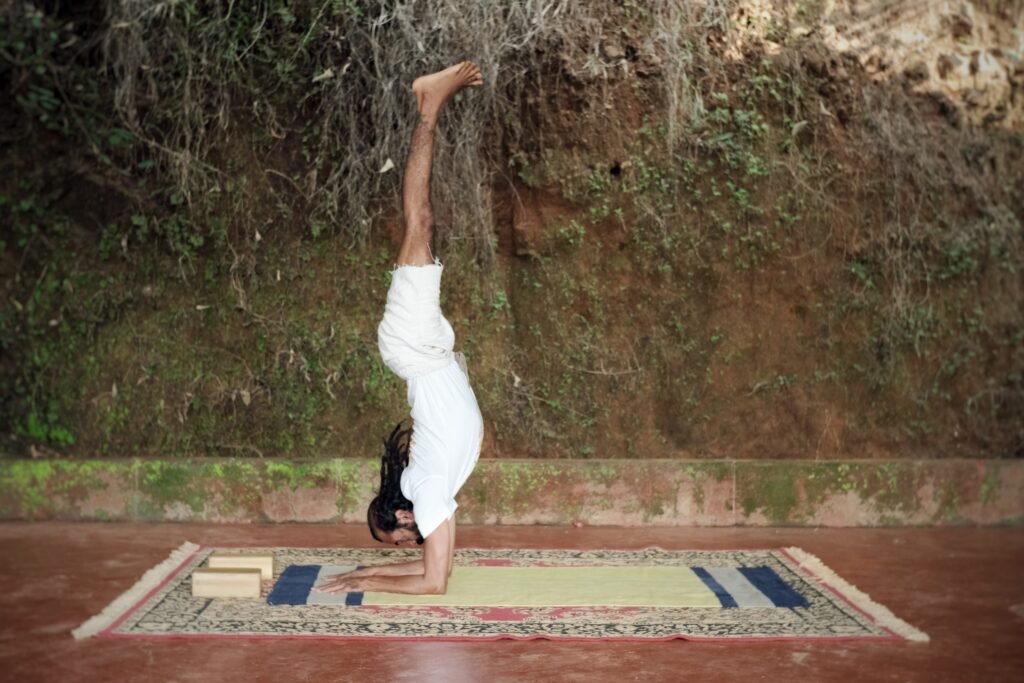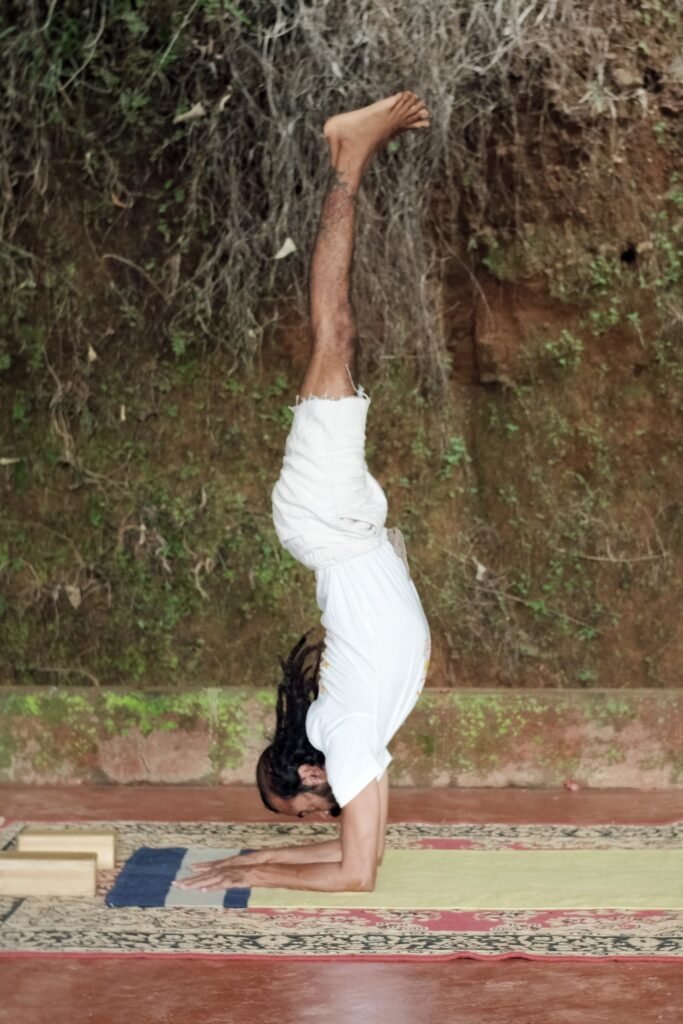
Pincha Mayurasana (Feathered Peacock Pose) is a challenging exercise created to test structural integrity, strength, and stability, as well as to master the aspects of Sukham and Sthiram (steadiness and calmness).
The Sanskrit words “Pincha,” “Mayur,” and “Asana,” which translate to “Feathered,” “Peacock,” and “Posture,” respectively, are used to name the pose. The body exhibits beauty and strength in its final position, resembling a peacock lifting its tail to reveal its vibrantly colored plumage.
Hence, Pincha Mayurasana, also known as the Feathered Peacock Pose.
Pincha Mayurasana Steps:
- Enter the Adho Mukha Svanasana to begin this asana (Downward-Facing Dog Pose).
- Lie down on the floor with the forearms on your elbows.
- Ensure that your forearms align with your shoulders and under your shoulders.
- Slowly lift your head while moving your legs toward your head. Your forearms and upper arms should be at a 90-degree angle.
- To start the inversion movement, tighten your shoulders inside the back of your torso.
- With your right knee bent, spring up onto it. Your left heel should be on the ground at this point.
- After you balance on your right leg, lift your left leg as well.
- Extend both legs straight up to the sky while keeping your elbows, forearms, and palms straight.
- Look forward while contracting your inner thigh and abdominal muscles and drawing your navel.
- Hold this position for 15 to 20 seconds. With regular practice, this duration can be extended.
- Lower your right leg first while taking a deep breath to exit the pose. Then, lower your left leg.
- Return to Adho Mukha Svanasana, straighten your elbows, and then release the pose.

Benefits of the Feathered Peacock Pose:
-
-
Stretches, Strengthens and Lengthens:
-
Holding the body on the forearms during Pincha Mayurasana strengthens and lengthens the biceps and triceps, wrists, elbows, arms, and shoulders. Core strength is also necessary to maintain the inversion balance.
When the head is raised off the floor, and the gaze is fixed slightly forward, the neck is stretched, strengthening the neck, upper, and middle back.
enhancing the strength of the upper body.
A challenging pose stretches the legs and opens the frontal body, strengthening the chest, back, thighs, and glutes.
-
-
Flexibility and Mobility:
-
Range of motion in shoulder and back is increased when the body is balanced on the forearms.
With this improved flexibility, students can be introduced to the advanced Pincha Mayurasana variations and other arm balance techniques.
-
-
Breathing, breathing, and the chest:
-
Although Pincha Mayurasana opens the front of the torso and stretches the neck, it can be challenging to breathe deeply due to the inversion style.
Additionally, the rib cage contracts as a result of the pressure on the muscles in the core and other parts of the body. The neck stretches activate the throat chakra, clearing any obstructions from the throat to the lungs that might prevent deep breathing.
As a result, the respiratory system’s performance is also improved.
-
-
Awareness and Focus:
-
Because the Feathered Peacock Pose is an inversion, it enhances balance and coordination.
It compels the practitioner to focus inward and notice how the body is balanced on the forearms.
Given the pose’s difficulty, it can be challenging to focus at first.
However, students can achieve awareness with regular practice or by initially balancing their bodies in Half Feathered Peacock Pose. As the flow of oxygenated blood to the brain increases, the mental function also improves.To prevent injuries or jerks, the pose also requires physical awareness.
-
-
Posture and alignment:
-
Strengthening the arms, shoulders, and back while lengthening the legs and spine toward the sky can help with posture. Students must maintain proper alignment by keeping their forearms parallel, their elbows directly under their shoulders, and their shoulders only shoulder-width apart. The legs must be joined to engage the core and squeeze the thighs toward one another.
When these alignments are corrected, the lengthening of the spine improves the spinal alignment. This position helps with posture.
To help maintain proper elbow and forearm alignment, however, a block between the hands or a strap around the arms can be added for beginners.
-
Energizing, De-stressing, and Relaxing:
Balancing the body in such challenging poses inspires students and has a significant positive impact on their physical, mental, and emotional energy, which leads to positive character change.
The heaviness in these areas will be released by the opposite blood flow in the direction of the head, neck, face, eyes, and ears. This will increase energy, fight fatigue, and foster a sense of empowerment and confidence.
-
Stimulation and Organs:
Pincha Mayurasana stimulates the reproductive and digestive systems through the active engagement of the core. Additionally, the cervical spine’s blood flow improves with a good neck stretch. The thyroid gland functions better as a result of this. Additionally, it aids in nervous system stimulation.
The brain becomes cool and memory-focused because blood is rushed down to it.
Blood that is nutrient- and oxygen-rich reaches the eyes and ears simultaneously, preventing any degeneration or other related problems.
-
-
Others:
-
In a spiritual sense, this pose opens the Ajna and Crown Chakras, which pave the way for Dharana and dhyana, or concentration and meditation, respectively, and the ability to hear one’s inner guidance.
-
-
Level-up:
-
Performing advanced poses like Handstand, Scorpion Pose, and Himalayan Duck Pose I requires a certain amount of strength, which Pincha Mayurasana helps to develop.
Contraindications for Pincha Mayurasana:
-
-
Injury and Surgery:
-
People with any injury to the related joints, such as the shoulders, neck, elbows, wrists, lower back, chest, rib cage, spine, hips, or legs, should refrain from performing the Feathered Peacock Pose. Additionally, students should take care of a neck or hamstring injury. Students who recently had abdominal surgery or are recuperating from a previous surgery involving the joints or body parts mentioned above should also avoid this pose.
-
-
Physical Strength and Weak Body:
-
Students with weak joints, the strain on any part of the body, past injuries, or physical illness should avoid this difficult pose.This pose should be avoided if you have knee or hip arthritis, a weak upper body, a weak back (an old herniated disc), or any issues with the nose, eye, or ear infections.
Due to the intolerable pressure on their eyes, glaucoma patients cannot perform the pose.
Students who experience severe acid reflux, fibromyalgia-related symptoms, tennis elbow, biceps tendonitis, rotator cuff tears or strains, bursitis, kyphosis, or IBD should also refrain from participating in this activity.
-
-
Lack of Body-Breath Connection:
-
Pincha Mayurasana emphasizes balance while requiring awareness. Lack of understanding of the relationship between the body and breath can make the practice uncomfortable and disrupt one’s energy levels. Additionally, as you hold your breath for a while during practice, your breathing becomes slower and deeper.
Therefore, this pose should be avoided by anyone with asthma, a cold or cough, or other breathing disorders.
-
-
Others:
-
Pregnant women should avoid the pose because it may be dangerous.
Because in the yogic system, the downward flow of energy (Apana Vayu) is responsible and active during the menstrual cycle, women should avoid this pose while experiencing their period. Additionally, students who struggle with sleep should avoid this activity because working in reverse gravity can overstimulate the nervous system, which increases energy.
